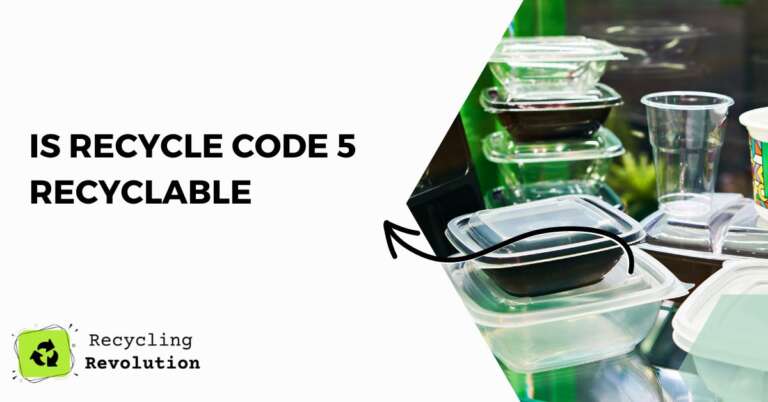One of the most common questions when it comes to the intricate world of recycling is, “Is Recycle Code 5 recyclable?” Recycle Code 5 refers to polypropylene, a plastic type used in a wide array of products, from yogurt containers to medicine bottles.
TL;DR: Is Recycle Code 5 recyclable? The answer, in short, is yes, but it’s complicated. Recycle Code 5, or polypropylene, can be recycled. However, it is not often accepted in curbside recycling programs due to the complexities and costs associated with recycling this material. Always check with your local recycling program to confirm.
Understanding Recycle Code 5
Recycle Code 5 is assigned to polypropylene, a type of plastic known for its durability, resistance to heat, and flexibility. It’s frequently used in packaging, automotive applications, and even clothing. Its versatility makes it widespread, but this also presents a challenge when it comes to recycling.
While Recycle Code 5 is technically recyclable, many municipal recycling facilities do not accept it due to the complexities and high costs involved in its recycling process. Polypropylene needs to be melted and remolded, which requires a lot of energy and sophisticated facilities.
Recycling Process of Code 5 Plastic
The recycling process of Code 5 plastic involves several steps:
- Collection: The first step is the collection of Code 5 plastic items, which can be challenging due to the lack of curbside pickup programs.
- Sorting: Next, recyclable materials are sorted based on their type. This step is essential because mixing different plastic types can ruin the recycling process.
- Cleaning: The sorted items are cleaned to remove any labels, adhesives, or other contaminants.
- Shredding: Cleaned items are then shredded into small flakes, which are easier to process.
- Melting: The flakes are melted and formed into pellets, which can be used to manufacture new plastic products.
What Can You Do?
Given the difficulties of recycling Code 5 plastic, here are some actions you can take:
- Check with your local recycling facility: Always verify what types of plastic your local recycling facility accepts. If they accept Code 5, make sure to clean and sort your plastic waste properly before recycling.
- Look for drop-off locations: Some grocery and retail stores have drop-off locations for specific plastic types, including Code 5. These programs often have partnerships with specialized recycling facilities.
- Reduce, reuse, and repurpose: The best way to address plastic waste is to reduce consumption. Consider reusing Code 5 plastic containers or repurposing them for storage or craft projects.
The Unseen Hurdles of Recycle Code 5
Recycling is not a universal process. The difficulties associated with recycling Recycle Code 5, or polypropylene, highlight the stark complexities involved.
For instance, one major issue is the economic viability of recycling Code 5. Given its lower recycling rate, the availability of Recycle Code 5 material for recycling is limited, thus making the process less cost-effective than recycling other materials like aluminum or paper.
Furthermore, there’s a matter of technology. Standard recycling equipment is not designed to handle the high melting point of polypropylene, making it challenging to process. Innovations are being made in this field, but they are yet to be widely adopted.
Another unseen hurdle lies in identifying and sorting Recycle Code 5. Although this plastic is stamped with its recycling number, the sorting process isn’t flawless. Contamination with other plastics can occur, which can disrupt the recycling process and produce a lower quality product.
Sustainability Considerations
While Recycle Code 5 presents difficulties in recycling, it’s essential to remember the broader sustainability picture.
Polypropylene, though challenging to recycle, has a lower environmental impact during production compared to other types of plastic. It uses less water and energy to produce, and it emits fewer greenhouse gases.
Market for Recycled Code 5 Plastic
Despite the challenges, there is a growing market for products made from recycled polypropylene. This demand can help drive improvements and investments in Recycle Code 5 processing technology. For example, recycled polypropylene can be used in landscaping fabric, brooms, bins, and auto parts.
Policy and Community Efforts
It’s worth noting that policy and community efforts can have a significant impact on the recyclability of Code 5. Some cities, for instance, are expanding their recycling programs to include more types of plastic, including Code 5.
In the future, we might see wider adoption of polypropylene recycling as technology advances and market demand grows.
Personal Efforts
As a consumer, your efforts matter. By choosing products with less packaging or seeking out those packaged in more readily recyclable materials, you can contribute to reducing the demand for challenging-to-recycle plastics.
Also, don’t underestimate the impact of voicing your concerns. Contact product manufacturers to express your wish for more sustainable packaging alternatives. Public demand can be a powerful driver of change.
Repurposing and Reusing Code 5 Plastics
Before tossing that Code 5 yogurt container in the recycling bin (or the trash if recycling isn’t available), consider if it could serve another purpose.
Many Code 5 plastic containers are sturdy and can be reused for storage. Polypropylene takeout containers, for example, can be washed and used again.
You can also get creative with repurposing. With a little imagination, a polypropylene bottle could become a bird feeder, or a small container might serve as a seedling pot for your garden.
Alternatives to Code 5 Plastic
If you are concerned about the challenges of recycling Code 5 plastic, you might want to consider alternatives.
- Biodegradable plastics: These are designed to break down in a composting environment, reducing the need for recycling.
- Glass or metal containers: Unlike plastic, glass and metal are endlessly recyclable without losing their quality.
Note: Always consider the lifecycle analysis of these alternatives. While they might seem more sustainable, the energy and resources required in their production and recycling process may negate these benefits.
Conclusion
While Recycle Code 5, or polypropylene, is technically recyclable, the process is fraught with challenges and complexities. Many local recycling programs do not accept it due to the high costs and specialized equipment needed for its recycling. However, with an understanding of these challenges, consumers can still make a positive impact.
Options include checking with local facilities for acceptance, seeking out drop-off locations, reusing or repurposing Code 5 plastics, and opting for sustainable alternatives like glass or metal. The recycling of Code 5 plastics also underscores the larger, intricate issues within recycling, from economic viability to technological hurdles.
However, growing market demand for recycled polypropylene, technological innovations, and policy and community efforts could usher in a more sustainable future for Code 5 recycling. Individual consumers play a significant role in this transition by making conscious choices and advocating for more environmentally friendly packaging options.
The complex situation surrounding Recycle Code 5 highlights the necessity of a nuanced approach to recycling and emphasizes the importance of reducing and reusing, not just recycling.
FAQs
What products commonly use Recycle Code 5?
Products that commonly use Recycle Code 5 include yogurt containers, medicine bottles, bottle caps, and some clothing material.
Why is Recycle Code 5 not often accepted in curbside recycling programs?
Recycle Code 5 requires specialized equipment and high energy input to recycle. It needs to be melted and reformed, which many municipal facilities are not equipped to do.
Are there alternatives to Recycle Code 5?
Yes, alternatives include biodegradable plastics or containers made of glass or metal. However, it’s important to consider the energy and resources used in their production and recycling processes.
What can I do if my local facility does not accept Code 5 plastic?
You can look for store drop-off locations that accept Code 5 plastic, or consider reducing your plastic consumption, reusing containers, or repurposing them for other uses.

